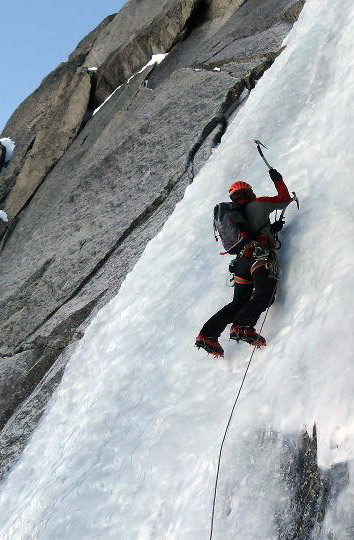MSRP: $240
Weight: 14-18oz
Thin Ripstop Nylon is an attractive choice for backpack manufacturers. It’s cheap, light and compressible. But alpine climbing on a regular basis will leave it looking more like a spaghetti strainer than a sack for carrying warm layers, gear, food and water. Instead, many climbing-specific pack makers use Dyneema-blend materials that are still lightweight but much more durable. Climbing in the Alps all winter, I put the Terra Nova Quasar pack and its “Ultra” fabric through an ice-and-granite gauntlet. While the pack is a little worse for the wear, it’s come out on the other side still capable of holding my gear.
A UK-based company, Terra Nova is well known in Europe for making lightweight expedition tents, bivy sacks, sleeping bags and emergency shelters. (They even hold the official record for “lightest tent in the world.”) They’ve recently started making packs, including a 30L, 45L and 55L alpine climbing pack called the Quasar.
Design
The streamlined Quasar looks a bit like an Ikea bag on steroids. Bells and whistles are kept to a minimum, but it does have side compression straps, two drawstring closures, two ice axe loops, a removable top lid with a hidden pocket underneath, two external side pockets, two removable accessory pockets for the hip belt, various external attachment points and a removable foam back pad.
Of these features, I am most impressed by the removable lid and “mini-lid” combo that allows you to tuck away the main lid and cover the drawstring closure with a simple patch. This also gives you a place to clip the two main closure straps so they are not dangling. Pretty clever! I also appreciate the easy-to-distinguish red haul loop and the low-volume waist belt that does not interfere with a harness.

The first design flaw I noted is the traditional ice axe loops that use an elastic cord to secure the tool to the pack. This system works fine while using an ice tool that has a hammer or an adze. However, it does not work well with a modern leashless tool, which more and more people are taking on alpine routes. A couple of simple vertical loops on the back panel would solve this problem without adding to the weight or taking away from the pack’s streamlined profile.
Second, there is not a good way to carry a sleeping pad on this pack! Making the side compression straps longer or adding some attachment points down the spine of the pack would solve this problem.
Finally, I would nix the external side pockets to make room for skis, if I had my way. While climbing, I don’t like the idea of carrying a water bottle on the outside since it will likely freeze or fall out. Also, snow wands are more commonly used on mountaineering/expedition style outings that require a larger pack volume, so this pocket should be omitted on the 30L design.
Construction
The main selling point of this pack is the weight. Stripped down to its minimum, the Quasar 30 weighs 14oz. Rigged with all its extras, it’s 18oz. For comparison, the CiloGear NWD 30L WorkSack weighs 17-31oz; Wild Things’ 26L Guide Pack is 28oz; Cold Cold World’s 40L Valdez is 34oz; and Hyperlite Mountain Gear has a 40L climbing pack that’s 26.5oz. (Keep in mind that the materials used to make these packs varies widely, so do your homework.)
Light is right, but you shouldn’t make a decision on weight alone. Durability is essential for a climbing pack that will have regular encounters with sharp, pointy gear, rock and ice. To make the Quasar, Terra Nova used their Ultra fabric, a three-layer, Dyneema-laced Cuben Fiber material, and a basic 500d Cordura on the base of the pack. The Quasar I tested also had a hybrid Dyneema-plus-Cordura material to reinforce high-abrasion areas, but newer models just have the Cordura.
Over the past few months, the Quasar took a beating on the Drus North Face, among a heap of other climbs and gully scrambles. It did not escape unscathed. There are now several holes in the fabric from scraping across the sharp granite of Chamonix and my own hasty packing (throwing crampons in the bag without any padding). Burlier fabric would have withstood some of the abrasion better, but nothing short of chain mail will hold up against sharp crampon points. Fortunately, the tears I put in the fabric have not propagated–a huge selling point for me. Even with small holes, this pack is still functional for alpine climbing as long as the fabric doesn’t fail completely. Overall I was impressed by the strength-to-weight ratio of this fabric.
While having a couple of shortcomings, Terra Nova’s Quasar is a solid performer in the gram-counting, alpine climbing niche. The Quasar strikes a balance between light weight and durability. And with its minimalist design, this pack is well suited for the modern alpinist, but not something I would take to the crag if I want the pack to last more than a season or two.
Pros: One of the lightest packs in its category; simple; top lid is removable; waist belt does not interfere with a harness; holes in the fabric don’t easily propagate.
Cons: Side compression straps are too short to carry a sleeping pad; securing leashless tools on the outside is a struggle; Fabric sacrifices some durability for light weight.